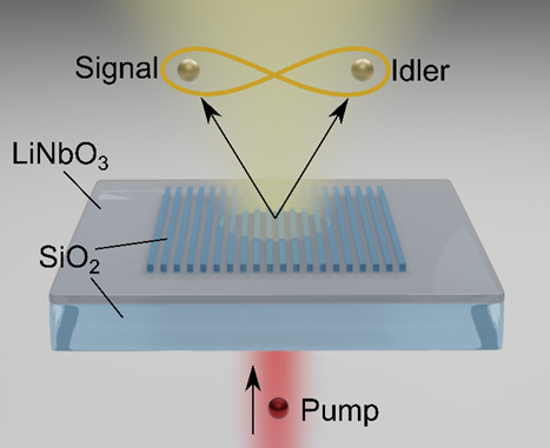Quantum entanglement is a key fundamental concept and an enabling feature for various quantum technologies, as recognized in particular by the Nobel Prize in Physics in 2022. When we say two particles are entangled, it means that certain properties of them remain linked, even when they are far apart, a phenomenon that Einstein thought implausible, dubbing it "spooky action at a distance." The photons, quasi-particles of light, can possess entanglement in different degrees of freedom such as frequency, spatial position, and propagation direction. Photon pairs that are entangled in the spatial degrees of freedom represent an essential resource for a broad range of quantum applications, including imaging, communications, and computations. Therefore, photon sources with tunable spatial entanglement are pivotal in quantum photonic technologies. The most common way to generate spatially entangled photon pairs is based on a process called spontaneous parametric down-conversion (SPDC), where a pump photon goes through a quadratically nonlinear material and spontaneously splits into two lower-energy photons that are emitted in different directions. Conventional SPDC sources rely on nonlinear crystals, which are bulky, with a typical thickness on the scale of millimeters to centimeters. In such thick crystals, the emission directions are limited to a certain predefined angle range, making it challenging to flexibly tune the spatial pattern and entanglement of the photon pairs while maintaining the generation efficiency.
Recently, it was shown that strong spatial entanglement can be achieved when reducing the thickness of nonlinear crystals to a few microns, less than one-tenth the diameter of a human hair. However, the generation efficiency became much weaker due to the reduced light-matter interaction length, and the spatial entanglement property is fixed. Thereby, it remained a challenge how to efficiently generate tunable spatially entangled photon pairs at a tiny scale. One way to boost the nonlinear SPDC efficiency is to pattern the nonlinear film into nanostructures, thereby creating a so-called metasurface that supports optical resonances and can enhance nonlinear processes.
The research group led by Prof. Andrey Sukhorukov from the ARC Centre of Excellence for Transformative Meta-Optical Systems (TMOS) at the Australian National University recently demonstrated experimentally a spatially entangled photon-pair source from a metasurface using lithium niobate (LiNbO3), a commonly used quadratically nonlinear material in photonic devices. In an invited paper published in the Special Issue on Optical Metasurfaces: Fundamentals and Applications in Chinese Optics Letters, Volume 21, Issue 1 (J. Zhang et al., Photon pair generation from lithium niobate metasurface with tunable spatial entanglement), the group went one step further and developed a new method to tune spatial entanglement of the generated photon pairs from the metasurface, which incorporates a 200-nanometer thick silica grating on top of a 300-nanometer thick film of lithium niobate, as shown in figure 1.

Fig. 1 Schematic of spatially entangled photon pair generation from LiNbO3 metasurface via spontaneous parametric down-conversion
This metasurface offers important advantages. Firstly, it doesn't need nanofabrication on the LiNbO3 so we can maximize the nonlinear material volume and avoid its possible damage in the nanopatterning process. Secondly, the grating can couple free-space light into the waveguide modes supported by the LiNbO3 film and excite the so-called guided mode resonance. This kind of nonlocal resonance has a high quality factor, meaning that the optical field can stay in the LiNbO3 layer for a long time and build up a strong field intensity, thereby boosting the SPDC efficiency. Furthermore, the resonance features a strong angular dispersion, that is, the resonant wavelength is dependent on the propagation direction of light. The latter property is the key to realizing tunable spatial entanglement.
In this work, the authors provided a full theoretical description of the two-photon state wavefunction generated from metasurfaces. It was found that the emission pattern and wavelength of the photon pairs can be varied continuously over a broad range by simply changing the wavelength or beam size of the pump laser. This is achieved by leveraging the strong angular dispersion of metasurface resonances. The photons are generated with near-degenerate wavelengths around double the pump wavelength, and the degree of their spatial entanglement is quantified by the so-called Schmidt number. It is shown that entanglement can be tuned between a weakly entangled state with Schmidt number close to one and strongly entangled states with an order-of-magnitude larger Schmidt numbers. A unique advantage of such a metasurface-based quantum source is that there is no need to tune its temperature or physical orientation, in contrast to traditional sources based on thick crystals that require careful temperature control to operate at different wavelengths.
"Controlling the temperature is inconvenient in everyday devices – mobile phones for example need to operate in a range of environments," said Dr Jihua Zhang who is the leading author of the paper.
"This type of light source with efficient control of the quantum entanglement can benefit free-space quantum communications and quantum imaging", said Dr. Jinyong Ma who is working on the quantum imaging application.
In the future, the metasurface platform is promising for the realization of hyperentanglement simultaneously in several degrees of freedom including spectrum, polarization, and orbital angular momentum, further broadening the application prospects.


